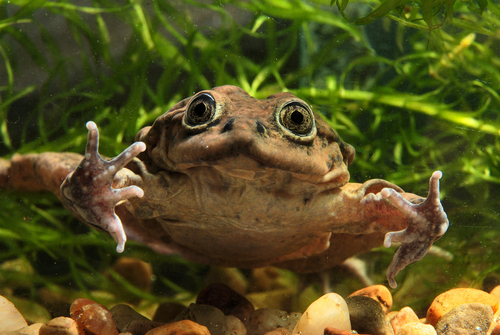
Lake Titicaca Frog
The Titicaca water frog, with its distinctive saggy skin, thrives in Lake Titicaca's high-altitude waters. This critically endangered amphibian uses its unique skin folds to breathe, playing a vital role in its aquatic ecosystem. Its survival is crucial for maintaining ecological balance in its native habitat.
15 years
Lifespan
255.0 g
Weight
Length: 20 cm
Size
Brown, Grey, Green
Color
5 years
Age of Sexual Maturity
Endangered
Conservation Status
Decreasing
Population Trend
Characteristics
Telmatobius culeus, commonly known as the Titicaca water frog, is an aquatic frog endemic to Lake Titicaca, located on the border of Peru and Bolivia. It is known for its extensive skin folds, which aid in oxygen absorption. This critically endangered species is adapted to high-altitude environments and has a unique breathing mechanism that allows it to thrive in oxygen-poor water.
Distribution Range of the Lake Titicaca Frog
Telmatobius culeus, commonly known as the Lake Titicaca water frog, is native to the region surrounding Lake Titicaca, which is located on the border between Peru and Bolivia in South America. This species is specifically endemic to this high-altitude lake environment.
Lake Titicaca Frog's Habitat
Environmental Conditions
Lake Titicaca is situated at approximately 3,812 meters (12,507 feet) above sea level, making it one of the highest navigable lakes in the world. The region experiences a cool climate with temperatures typically ranging from 0°C to 14°C (32°F to 57°F). The lake's waters are cold and well-oxygenated, which are critical conditions for the survival of the Lake Titicaca water frog.
Ecological Niche
Telmatobius culeus is adapted to an aquatic lifestyle, spending most of its life in the lake's waters. It primarily inhabits shallow areas with abundant vegetation, which provide both shelter and feeding opportunities. The frog is known for its extensive skin folds, which increase surface area for cutaneous respiration, an adaptation to the low-oxygen environment of high-altitude waters. This species plays a role in the aquatic ecosystem as both a predator and prey, feeding on invertebrates and being preyed upon by birds and other animals.
Copyright @ Nature Style Limited. All Rights Reserved.
 English
English